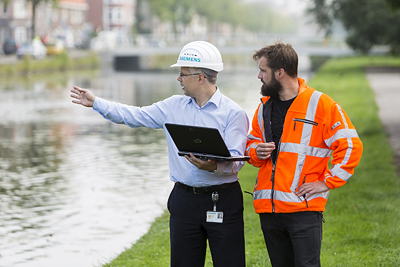Early Warning System for Dikes Passes Field Test

Technology developed by Siemens for this has now passed its field test, which was conducted on a chain of sensors spread out along a length of five kilometers of a dike in Amsterdam. The sensor system permanently records and transmits data on the dike's condition. Experts believe such automated dike monitoring can reduce maintenance costs by ten to maximally 20 percent.
Dike protection is becoming more important around the world as sea levels rise and the incidence of storms increases. More than two-thirds of all European cities are now examining ways to protect themselves from river and ocean flooding. According to the Munich Re reinsurance company, flooding accounted for nearly 40 percent of all damage caused by natural disasters worldwide in 2013.
Real time information available
Waternet Amsterdam is the pilot customer for the dike monitoring trials and the operator of the local drinking and wastewater network. The company is also responsible for more than 1,000 kilometers of dikes. These dikes protect 700 square kilometers of land on which more than one million people live. The dikes used to undergo maintenance work every five to 30 years, depending on their material. Regardless if that was sand, clay, peat, or soil, the dikes' stability had to be measured at regular intervals. Experts inspected them every few years and sank measuring devices into the ground.
Today, information can be called up in real time on smartphones. In order to extend sensor battery life, reports on dike conditions are only sent once an hour, although if danger is detected reports will be sent in one-minute intervals. The data is collected by sensors that are inserted into the dike around every 100 meters. The sensors are located above and below the surface of the water, where they measure the temperature, pressure, and humidity within the dike, as well as the depth and temperature of the water in the canal. The results are then sent via GPRS to a control center, where the data is processed and compared with long-term historical measurements.
Warmer dike means water has seeped in
If, for example, an interior temperature of 14 degrees Celsius is measured within a dike, it could be an indication that the levee is about to break because warmer water has seeped in. That's because groundwater – and thus the inside of a dike – has a temperature of about eight degrees. The system compares the real-time data with the history. For example, it measures the height of the water table and then calls up data on the amount of precipitation that normally falls in the area at that time of year- and whether there was a recent drought that would allow the dike to take in more water or if the dike is already saturated. The material the dike is made of also plays a role because it makes it possible to determine how likely a landslide is.
The neural networks used can distinguish between typical and atypical deviations. They can often sound an alarm weeks or months before a problem occurs. If conditions along a number of sections are the same, the software system can even draw precise conclusions about those dike sections which are not equipped with sensors.
Weitere Informationen:
Media Contact
All latest news from the category: Power and Electrical Engineering
This topic covers issues related to energy generation, conversion, transportation and consumption and how the industry is addressing the challenge of energy efficiency in general.
innovations-report provides in-depth and informative reports and articles on subjects ranging from wind energy, fuel cell technology, solar energy, geothermal energy, petroleum, gas, nuclear engineering, alternative energy and energy efficiency to fusion, hydrogen and superconductor technologies.
Newest articles
Humans vs Machines—Who’s Better at Recognizing Speech?
Are humans or machines better at recognizing speech? A new study shows that in noisy conditions, current automatic speech recognition (ASR) systems achieve remarkable accuracy and sometimes even surpass human…

Not Lost in Translation: AI Increases Sign Language Recognition Accuracy
Additional data can help differentiate subtle gestures, hand positions, facial expressions The Complexity of Sign Languages Sign languages have been developed by nations around the world to fit the local…

Breaking the Ice: Glacier Melting Alters Arctic Fjord Ecosystems
The regions of the Arctic are particularly vulnerable to climate change. However, there is a lack of comprehensive scientific information about the environmental changes there. Researchers from the Helmholtz Center…



